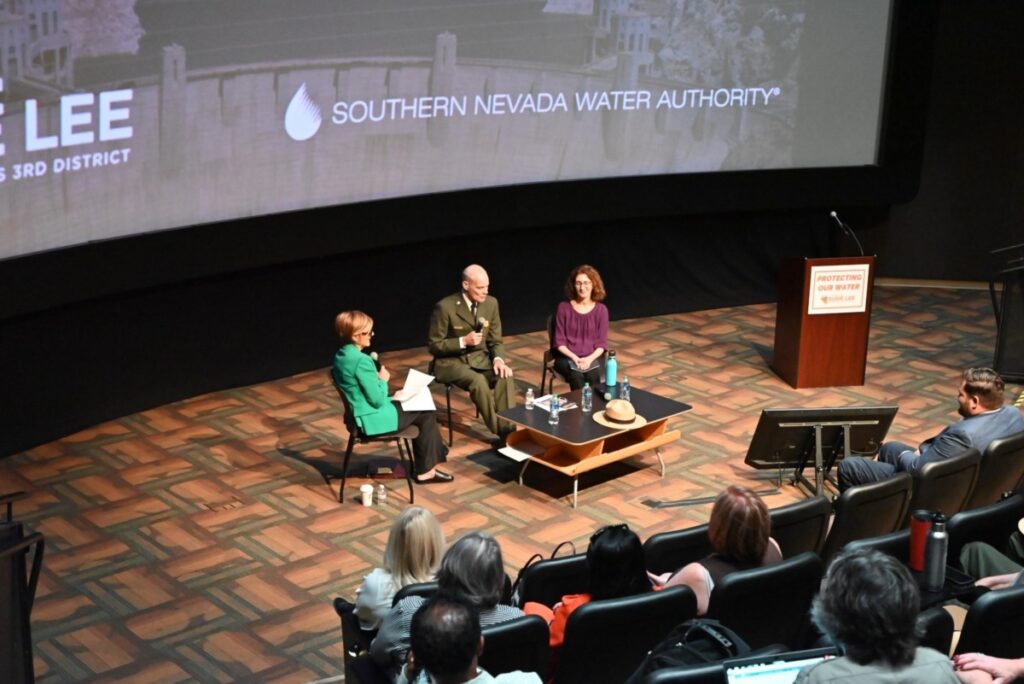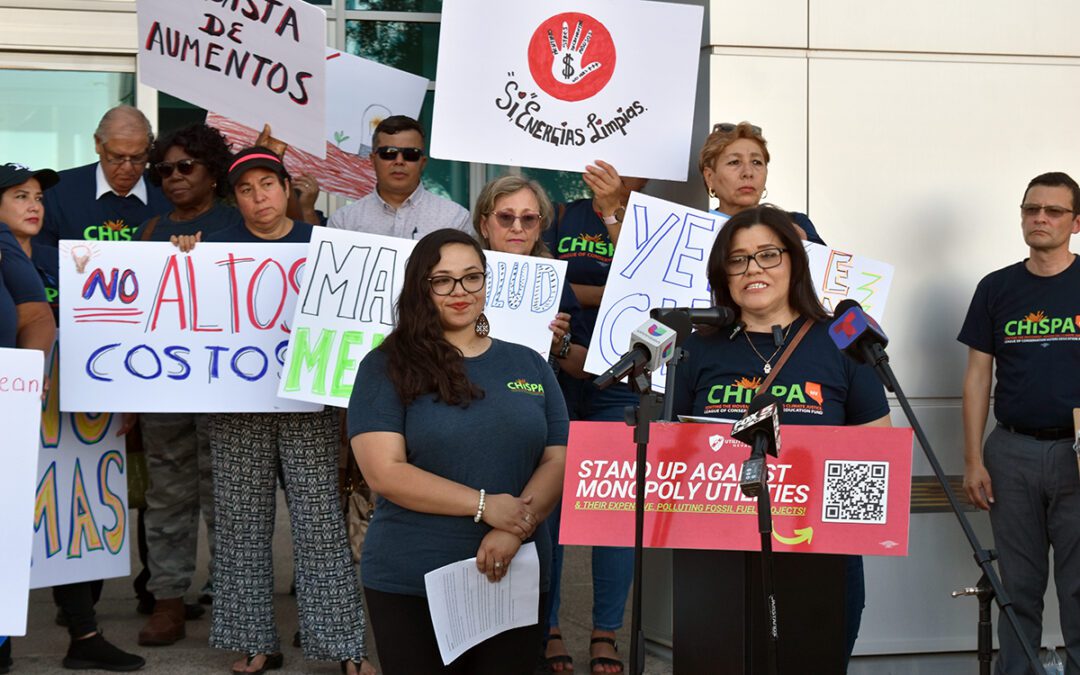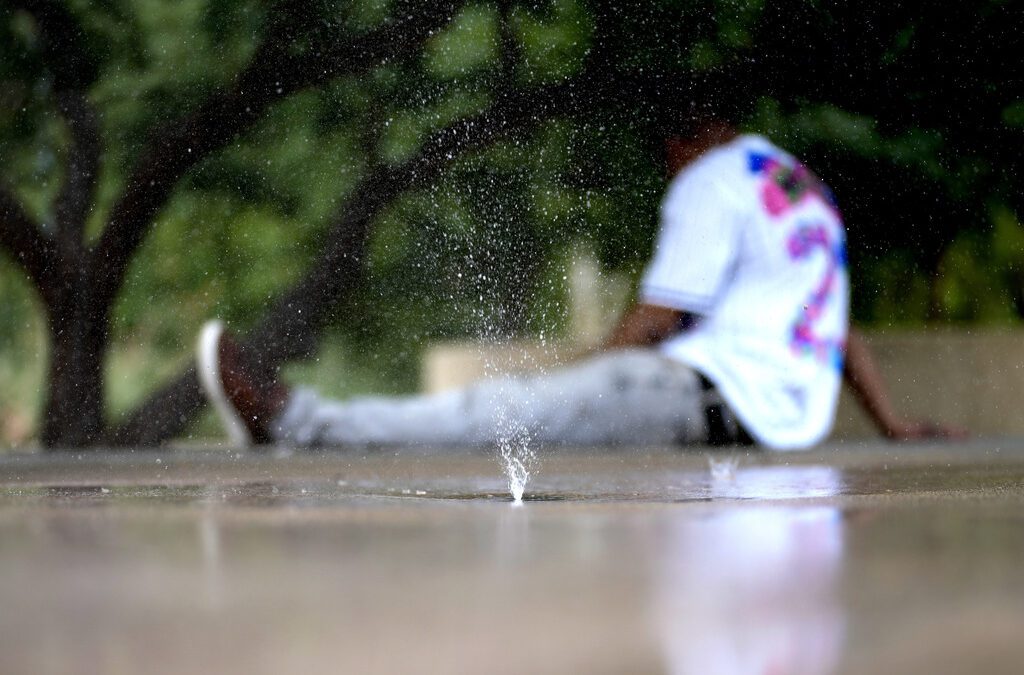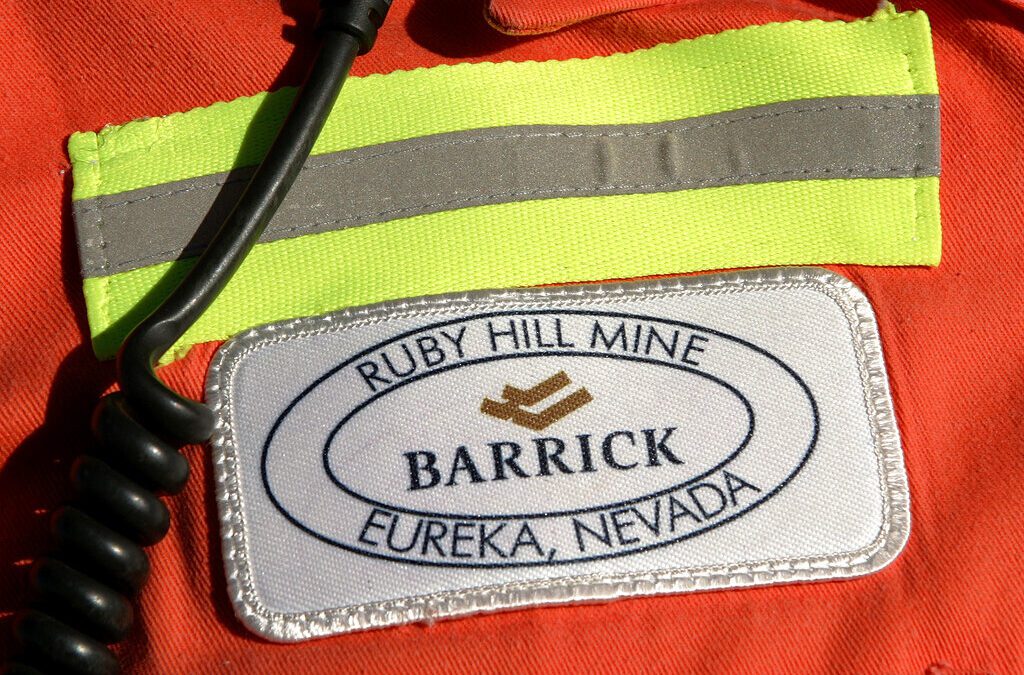
From left to right, Nevada US Rep. Susie Lee, Lake Mead National Recreation Area Superintendent Mike Gauthier, and US Bureau of Reclamation hydrologist Shana Tighi speak at the Southern Nevada Water Summit on Aug. 14, 2024, at the Springs Preserve natural history museum in Las Vegas. (Photo credit: Courtesy, US Rep. Susie Lee's office)
A snowier-than-usual winter combined with billions in federal funding from the Bipartisan Infrastructure Law and Inflation Reduction Act have helped stave off the worst of proposed mandatory cuts for states that depend on the Colorado River for water.
Legislation enacted by the Biden-Harris administration seems to be helping water levels in Lake Mead rebound from historic lows amid a decades-long drought, federal and local water officials said this week, though more action may still be needed to ensure water rights on the Colorado River remain solvent for years to come.
Lake Mead recorded an elevation of 1,040 feet in July 2022 — the lowest level since the federal government first filled the reservoir in 1937 — raising concerns that lake levels could get so low the hydroelectric power plant at the Hoover Dam wouldn’t be able to generate electricity.
But a snowier-than-usual winter combined with billions in federal funding from the Bipartisan Infrastructure Law and Inflation Reduction Act have helped stave off the worst of proposed mandatory cuts, Colby Pellegrino, Deputy General Manager of Resources at the Southern Nevada Water Authority told attendees of the second annual Southern Nevada Water Summit on Wednesday.
“I really think these two bills are what helped catalyze the lower basin agreements,” Pellegrino said. “We were really on the brink of catastrophe, mother nature was kind to us and Congress was very kind to us. And those two things together are what enable us to get there voluntarily, because I’m fairly certain we would have been in court otherwise.”
California, Nevada, and Arizona agreed last May to conserve a cumulative 3 million acre-feet of water through the end of 2026 in return for increased subsidies made available through the Inflation Reduction Act. Those subsidies depend on how long users agree to the restrictions but can be as high as $400 per acre-foot conserved, according to a Stanford University analysis of the agreement.
Bureau of Reclamation Commissioner Camille Touton said her agency has also been able to invest $8.3 billion through the Bipartisan Infrastructure Law over five years for water infrastructure projects, such as a proposed state-of-the-art Los Angeles-area water recycling plant that officials say will be the largest of its kind in the US once finished, as well as other various projects aimed at improving drinking water quality. That also includes $281 million for more than 20 other recycling projects, $233 million for water conservation funding, $73 million for infrastructure repairs to water delivery systems, $71 million for drought resiliency projects, and other investments.
The event Wednesday was hosted and emceed by Nevada Democratic US Rep. Susie Lee, who voted to pass both the Bipartisan Infrastructure Law and Inflation Reduction Act, and has long stressed the importance of cooperation between all levels of government to promote water conservation in the West.
“It’s up to all of us to tackle the ongoing effects of the worst drought in 12 centuries by identifying opportunities and breakthroughs,” said Lee. “Gatherings like this are critical and important, really, one, to promote education, but also to promote partnerships, because we all know when we work together, we can solve pretty much any problem.”
Water levels have somewhat rebounded over the past two years, with the most recent estimates showing Lake Mead elevation this month up about 20 feet compared to this time in 2022. Still, Lake Mead currently sits at about 33% capacity, and more work will be needed by all river users to help preserve its viability in the decades to come.
Lake Mead is one of two main reservoirs on the Colorado River, the body of water that Nevada, six other Western US states, more than two dozen Native American tribes, and Mexico rely on for water. The Colorado River Basin itself is split into an upper region consisting of Wyoming, Colorado, Utah, and New Mexico, while Nevada, California, and Arizona are defined as lower basin states. Along with Lake Mead, the Colorado also flows into Lake Powell, and provides water for roughly 40 million Americans.
The river also irrigates millions of acres of farmland in the American West and generates hydropower used across the region. Years of overuse combined with rising temperatures and drought have meant less water flows in the Colorado today than in decades past.
A series of overlapping agreements, court decisions, and contracts determine how the river is shared, some of which expire at the end of 2025. That’s made the fraught politics of water in the West particularly deadlocked at times.
In 2007, following years of drought, the seven US states in the basin and the federal government adopted rules to better respond to lower water levels at Lake Mead and Lake Powell. The 2007 rules determine when some states face water cuts based on levels at Lake Mead. That’s why states, Native American tribes, and others are drafting new plans, which anticipate even deeper water cuts after 2026, based on projections of the river’s flow and climate modeling of future warming in the West.
The infusion of cash from the Biden-Harris administration has certainly helped ease tension among river users, but everyone involved will still need to tighten the belt to some degree, said Colby Pellegrino, Deputy General Manager of Resources at the Southern Nevada Water Authority.
Even without the cuts Nevada agreed to last year, the Silver State is consistently one of the most efficient Colorado River users and has become a model for municipal conservation not only in the drought-stricken west, but across the world, said Touton.
While Nevada’s population has increased by 52% over the last two decades, water use has declined by about 40%, Touton said. Southern Nevada is able to largely recycle most of the water it draws from Lake Mead which is just a few dozen miles outside of Las Vegas, allowing water to quickly and efficiently be returned for treatment.
Coupled with policy decisions like a 2021 law that prohibits irrigation of Colorado River water for nonfunctional turf, plumbing efficiencies, and the groundswell of recent federal federal funding, agencies like the SNWA can serve as a model for other agencies tasked with navigating a hotter and drier climate.
“It is a generational investment,” Touton, who grew up in Las Vegas, said of the two federal laws. “When you add these together across the West, it makes for a more sustainable system overall.”
The Associated Press contributed to this report.

Condena Chispa Nevada el retiro de apoyo en su pago de electricidad a familias de bajos ingresos
Chispa Nevada condena que la administración Trump retire ilegalmente el financiamiento del programa de Nevada para reducir las facturas de...

Biden admin moves to shield Nevada public lands from mining with support of tribes, local leaders
In one of President Biden’s last moves in office, his administration has moved to protect 269,000 acres of public land in Nevada from a proposed...

Many fear help for Nevada water conservation will dry up under Trump
Despite billions from the Inflation Reduction Act going to benefit Nevada, President-elect Donald Trump and conservative fiscal hawks may pursue a...

Grant from Biden infrastructure law to help install 185 EV charges around Las Vegas valley
A $3.2 million grant from the US Department of Transportation will help fund and install electric vehicle charging stations in primarily...

Almost 500 people have died from extreme heat in Las Vegas in 2024, officials say
Factors relating to extreme heat accounted for 491 deaths and more than 3,500 emergency room visits, according to Clark County officials, as Las...

Nevada gold mining venture selected for $95M solar project
After being awarded a federal grant to help decarbonize the mining industry, Nevada Gold Mines hopes to build two on-site solar panel and battery...





